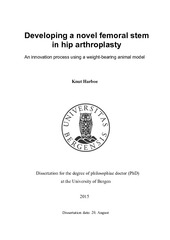Developing a novel femoral stem in hip arthroplasty. An innovation process using a weight-bearing animal model
Doctoral thesis
Permanent lenke
https://hdl.handle.net/1956/10366Utgivelsesdato
2015-08-20Metadata
Vis full innførselSamlinger
Sammendrag
Introduction: To address the growing incidence of hip replacement revision, this project aimed to find a stem that would fulfil three criteria. First, solid osteointegration and long survival of the implant. Second, easy removal, if deemed necessary. Third, little or no bone loss at the time of revision to facilitate the implantation of the revision stem. Methods: A stem of our own design was implanted in two animal series. Study 1 was performed in 2006, and 12 goats were operated upon. Study 2 was performed in 2008 and included 35 goats. In both studies, the goats were observed for 6 months, and full weight-bearing was permitted. After the goats were euthanised, the stems were randomised to drilling or no drilling of the area of osteointegration and tested biomechanically for differences in pull-out force. In Study 1, the implants were coated with calcium phosphate (CP); in Study 2, hydroxyapatite (HA) was used instead. Histological analysis was performed in both studies. Results: A significantly lower pull-out force was observed in Study 2 after drilling in the area of osteointegration (mean, 1526 N vs. 2033 N, p = 0.028). The calcium phosphate coating was inferior in performance to hydroxyapatite regarding bone apposition and pull-out force (CP mean, 174 N vs. HA 1526 N, p = 0.003). No correlation of the bone apposition evaluated by histology and pull-out force was observed. In addition, there were no signs of inflammation. Conclusion: A significant effect of drilling longitudinally orientated grooves in a femoral stem in goats to reduce pull-out force was observed. The hydroxyapatite coating appears preferable to calcium phosphate on TiAl6V4-loaded implants with respect to bone apposition and pull-out force. Bone growth towards the femoral stem was not correlated with the pull-out force of the implant.
Består av
Paper I: Harboe K, Enoksen CH, Gjerdet NR, Sudmann E. Development of a femoral stem providing strong anchorage and facilitated removal. An experimental study in goats. Vet Comp Orthop Traumatol. 2012; 25(2):95-101. The article is not available in BORA due to publisher restrictions. The published version is available at: http://dx.doi.org/10.3415/vcot-11-02-0032Paper II: Harboe K, Gjerdet NR, Sudmann E, Indrekvam K, Søreide K. Assessment of retention force and bone apposition in two differently coated femoral stems after 6 months of loading in a goat model. J Orthop Surg Res. 2014;9:69. The article is available at: http://hdl.handle.net/1956/8396
Paper III: Harboe K, Ellingsen CL, Sudmann E, Gjerdet NR, Søreide K, Indrekvam K. Can bone apposition predict the retention force of a femoral stem? An experimental weight-bearing hip-implant model in goats. BMC Musculoskelet Disord. 2015;16:102. The article is available at: http://hdl.handle.net/1956/10365
